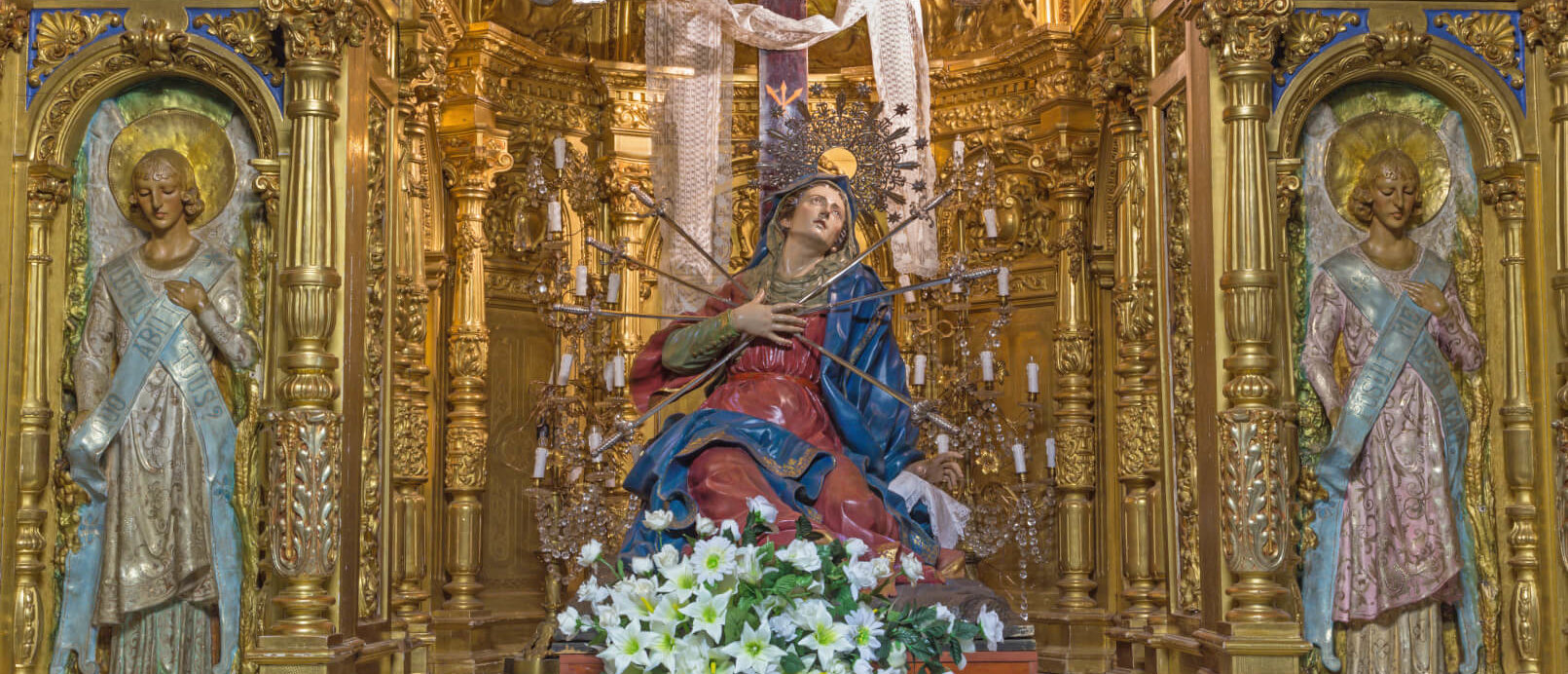Today the Church reflects upon the sufferings of Mary, most notably remembered through the Seven Sorrows and the Seven Sorrows Rosary (popularized by the Servite and Dominican Orders). But for many of us, meditating upon these pivotal sorrows that accompanied the Son of God’s life and ministry can present a challenge to our joy-filled and hopeful faith.
The Gospels give us the Seven Sorrows upon which we typically meditate, moments which are “pivotal” in the life of Mary and Jesus: the Prophecy of Simeon (Luke 2:35); the Flight into Egypt (Matthew 2:13); the Loss of the Child Jesus in Jerusalem (Luke 2:46-48); Mary meeting Jesus on the way to Calvary (Luke 23:27); the Crucifixion and Death of Jesus (John 19:25-27); Mary receiving the Body of Jesus from the Cross (an implication in John 19:38 that has been utilized for images like the Pietà); and the Burial of Jesus (an implication in Luke 23:55-56).
When we live these sorrows ourselves, we gain a new perspective on each of these mysteries. But how can we relate to, or even understand, these if we have not yet experienced – or may never experience – some of these mysteries? How do we reconcile them with the joyful faith we know and practice?
Fr. Edward Looney, an officer of the Mariological Society of America and devoted mariologist, suggests some ways in which we may still find comfort in these sorrows, no matter our familiarity with them, and even meditate upon them with joy and hope. The feast’s original twelfth-century name, Our Lady of Compassion (from Latin roots meaning, “to suffer with”), clearly indicated that the Mother of God, who knew joy and connection with God free from Original sin, still knew the heartbreaks that we regularly address: Our Lady is no stranger to suffering, and yet in her anguish she holds hope in God, trust in His plan, peace in His providence, and comfort for her children on earth (given in John 19:25-27: “Behold your son…behold your mother”).
He recommends meditating on the many sorrows within litanies, such as the Litany of the Immaculate Heart or the Litany to Our Lady of Seven Sorrows. The repetition, as well as the variety of titles and names we are given, may turn our hearts to new directions and insights.
“At different points in our lives, we’re going to resonate with Our Lady of Sorrows,” Fr. Looney reflected from his own experience and his extensive studies into everyday Marian devotions, “Seven sorrows is just the beginning. A sorrow of Mary could also be Jesus leaving to begin His ministry, the death of Joseph… when you experience [sorrows], like Mary experienced them, you’ll be able to say, “Mary, be close to me now”. You know that Mary knows what it’s like.”
What is also important to remember about these sorrows is many are companions to great joy. The Presentation of Jesus is, overall, a very joyful ritual; Mary and Joseph find Jesus after days of searching, safe and teaching in the Temple in Jerusalem; the Resurrection follows quickly after the Passion of Christ. In each of those sorrows, hope can be found.
Let us approach Our Lady each day, in our joys and sorrows, big and small, for a new heart and a new hope for all that is to come. Let us lean on Our Mother of Compassion, knowing that she has shared in our joys and our sorrows, and find a new tenderness for our sufferings and those around us.
Our Lady of Sorrows, pray for us!

Our Lady is celebrated under many names, from popular apparitions to small-town titles. Each reveal something different about the Blessed Mother to us – and affirms what we already know of her love and intercessory power! Deepen your devotion to Our Lady with Miracles, Mysteries, & Mary, a monthly collection of stories, Church teaching, reflections, and so much more – guaranteed to expand your knowledge of Our Blessed Mother. Sign up today to receive this Marian content, right to your inbox, and check out our archive page to catch up on our year of Our Lady!



